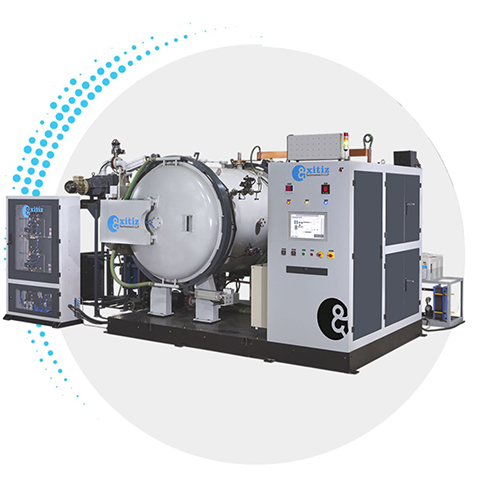Specification
- शर्त
- उपयोग
- प्रॉडक्ट टाइप
- Vacuum Heat Treatment सेवाएं
- रंग
- Silver
- वारंटी
- 1 Year
Trade Information
- आपूर्ति की क्षमता
- प्रति दिन
- डिलीवरी का समय
- दिन
- पैकेजिंग का विवरण
- Customers package
- मुख्य घरेलू बाज़ार
- प्रमाणपत्र
- ISO 9001: 2015, IATF 16949; 2016
About
DEFINITION:
Vacuum Heat Treatment by XITIZ furnace is a controlled thermal processconducted in a vacuum environment to alter the physical and mechanicalproperties of materials, ensuring high precision, cleanliness, and enhancedperformance. It is extensively used in industries requiring stringent qualityand reliability standards.
KEY FEATURES:
Vacuum Atmosphere: Pressurelevels range from 10 to 10 mbar toensure minimal contamination and oxidation. Allows treatment without the needfor protective gases like in conventional heat treatments.
Temperature Control: Canachieve temperatures up to 2500 deg C,depending on the material and equipment.
Ensures uniform heating and cooling for consistentresults.
Cooling Options:
Controlled cooling using inert gases like nitrogen, helium, or argon. Adjustablecooling rates meet specific material property requirements.
Advanced Automation:
Equipped with programmable logic controllers (PLCs) forprecise process control and repeatability.
Surface Integrity:
Produces bright, clean, and oxidation-free surfaces,eliminating post-treatment cleaning.
APPLICATIONS:
1.Aerospace Industry : Turbine blades, jet engine components,and landing gear are vacuum heat-treated for durability, precision, andresistance to extreme environments.
2.Automotive Industry: Critical components like gears,transmission shafts, and fuel injection parts are hardened to enhance wearresistance and fatigue strength.
3.MEDICAL INDUSTRY: Surgical instruments and implants (e.g.,orthopedic screws, plates) are treated for corrosion resistance andbiocompatibility.
4.Energy Sector: Components in power plants, such as steamand gas turbines, benefit from superior heat and oxidation resistance.
5. TOOLMANUFACTURING: Dies, molds, and cutting tools are treatedfor hardness, dimensional stability, and wear resistance.
ADVANTAGES OF VACUUM HEAT TREATMENT:
Oxidation-Free Processing:Eliminates scaling and decarburization for a polished, clean finish.
Precision and Uniformity:Tight control over temperature and atmosphere ensures consistent mechanicalproperties.
Material Preservation: Idealfor sensitive materials like titanium and superalloys that degrade in traditionaltreatments.
Environmentally Friendly:No harmful byproducts; eliminates the need for chemical cleaning agents.
Enhanced Performance: Materialsexhibit superior strength, hardness, fatigue resistance, and corrosionresistance.
COMMON PROCESSES PERFORMED IN VACUUM HEAT TREATMENT:
Hardening: Increasesmaterial hardness for wear resistance.
Tempering: Reducesbrittleness while maintaining hardness.
Annealing: Relievesinternal stresses, improves ductility, and refines microstructure.
Solution Treatment: Dissolvesprecipitates for uniform material properties.
Brazing: Joins componentswith minimal distortion and a clean finish.
COMMON MATERIALS TREATED:
Carbon Steels (e.g., AISI 1045, 4140)
Stainless Steels (e.g., 304, 316, 17-4 PH)
Titanium Alloys (e.g., Ti-6Al-4V)
Nickel-Based Superalloys (e.g., Inconel, Hastelloy)
Tool Steels (e.g., D2, H13)
KEY APPLICATIONS
Aerospace : Treatment ofturbine blades, landing gear, and engine components for superior fatiguestrength and oxidation resistance.
Automotive : High-precisionhardening of gears, camshafts, and fuel injection components to meethigh-performance standards.
Medical : Treatment ofsurgical tools, implants, and biocompatible components with enhanced surfaceproperties.
Tooling : Vacuumhardening and tempering of dies, molds, and cutting tools for durability andwear resistance.
Customized Solutions: Tailoredvacuum systems to meet specific customer needs.
Advanced Process Control:Integration of programmable logic controllers (PLCs) for repeatable andaccurate processes.
High Throughput and Reliability:Designed for high production rates with minimal downtime.
Sustainability: Focusedon energy-efficient designs and environmentally friendly processes.


Price: Â
- 50
- 100
- 200
- 250
- 500
- 1000+



